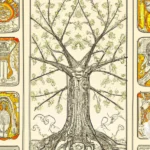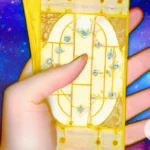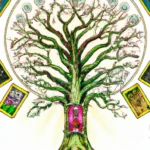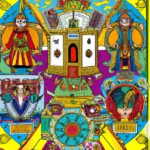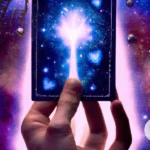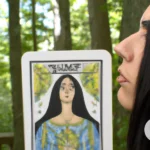As we delve deeper into the mystical world of tarot, we may come across certain concepts and symbols that seem esoteric and perplexing. One such concept is that of the Ten Sephirot, a collection of mystical principles that form the basis of the Kabbalistic Tree of Life. Each Sephirah, or sphere, represents a specific aspect of existence and consciousness, all interconnected and influencing one another. This article will explore the meaning and significance of each Sephirah, and how they relate to the tarot cards that correspond to them. So, let’s dive into this mysterious and fascinating realm and unveil the secrets of the Ten Sephirot in tarot.
What are the Ten Sephirot?
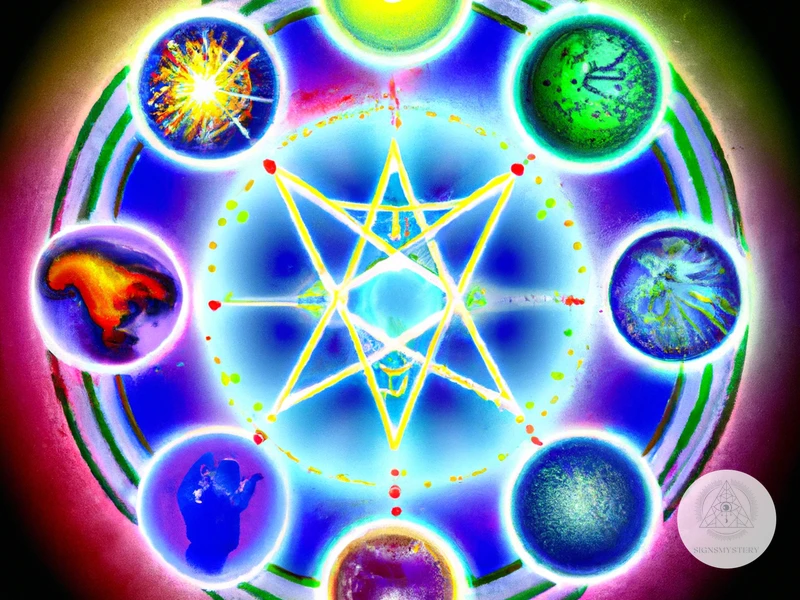
As we delve into the realm of Tarot, we encounter a number of mystical elements that have been integrated into the practice. One of these elements is the Ten Sephirot, which are an integral part of Kabbalistic thought. The Sephirot are a complex system of divine attributes and energies that are said to define the nature of creation and the universe. They are represented by a diagram known as the Tree of Life, which is used not only in Kabbalah but also in Tarot. Understanding the Ten Sephirot is crucial for anyone looking to deepen their knowledge of Kabbalah and its relationship to the Tarot. So, let’s explore each of the Ten Sephirot in detail and reveal their meanings and significance in the Tarot. If you want to learn more about the connection between Kabbalah and Tarot, check out this article on Tree of Life Tarot Correspondences.
1. Kether
Kether is the first of the ten Sephirot, located at the top of the Tree of Life. It represents the purest form of divinity, the Crown, and is often associated with the concept of oneness with the divine. Kether is sometimes referred to as the “source of all,” as it is the point from which all creation emerges.
Some of the key attributes associated with Kether include unity, infinite potential, and enlightenment. This Sephirah is considered to be the highest point of spiritual attainment in the Kabbalistic tradition. It is believed that the journey towards Kether involves a process of shedding the ego and identifying with the divine essence within oneself.
In Tarot, Kether is associated with the Fool card, which represents the beginning of a journey towards self-discovery and spiritual enlightenment. The Fool is often depicted as a figure stepping off a cliff into the unknown, representing the idea of taking a risk and trusting in the journey ahead.
Kether is an important concept in Kabbalistic Tarot, as it represents the ultimate goal of spiritual attainment. Understanding the symbolism of Kether can help in interpreting the Fool card and other cards that represent the beginning of a new journey or phase in life.
For more information on the connection between Kabbalah and Tarot, check out our article on Understanding Major Arcana and Kabbalah. You may also be interested in learning about the Kabbalistic Court Cards or how Kabbalah can enhance your Tarot readings. Check out Kabbalistic Court Cards or Kabbalah and Tarot Enhancement. Additionally, incorporating Kabbalah into your daily life can help with spiritual growth and presence; learn more about this in Kabbalah and Tarot Presence.
2. Chokmah
Chokmah, also known as Wisdom, is the second Sephirah on the Tree of Life in Kabbalah. It represents the masculine aspect of creation and is associated with the primal formless energy of the universe.
| Attribute | Description |
|———–|————-|
| Hebrew Name | חכמה |
| Meaning | Wisdom |
| Position | Top of the right pillar |
| Tarot Card | The Magician |
| Astrological Sign | The Zodiac |
| Element | Air |
Chokmah is often represented as a father figure and is associated with the power of creation. This Sephirah is the embodiment of masculine energy and represents the spark of creation that initiates the process of manifestation.
The Tarot card associated with Chokmah is The Magician, which is a powerful representation of the energy of creation that Chokmah represents. The Magician is often depicted as a wise and powerful figure, capable of harnessing the power of the universe to manifest his will.
In astrology, Chokmah is associated with the Zodiac, which represents the twelve constellations and their influence on our lives. It is also associated with the element of Air, which represents the power of the mind and the ability to communicate and express oneself effectively.
Chokmah represents the power of creation and the masculine energy that drives the process of manifestation. It is a powerful force that must be harnessed with wisdom and understanding, and The Magician is an excellent representation of this concept in the Tarot.
3. Binah
Binah is the third Sephirah on the Tree of Life in the Kabbalah, representing understanding, intelligence and wisdom. It is often associated with the feminine aspect of the divine and is considered to be the mother or womb of creation. The Hebrew word Binah means “understanding”, and it is through Binah that we gain deep insights and comprehension of the world around us.
In tarot, Binah is represented by the card ‘The High Priestess’, which embodies the attributes of intuition, knowledge and contemplation. When this card appears in a reading, it suggests that one should trust their inner voice and seek answers within.
The following are some key attributes and symbolic associations of Binah and ‘The High Priestess’:
– Feminine energy: Binah represents the feminine aspect of divinity, and the card ‘The High Priestess’ is often depicted as a woman with deep intuition and understanding.
– Water: Binah is associated with the element of water, which represents the flow of emotions, intuition and the subconscious.
– Black and white: In Kabbalistic tradition, Binah is associated with the colours black and white, which represent the polarity of light and darkness, and the balance between them.
– The moon: The High Priestess card is often depicted with a crescent moon, which represents the cycle of creation and destruction, as well as the ebb and flow of the tides.
– Passivity and receptiveness: Binah is considered to be a passive and receptive force, as it is through understanding and contemplation that we gain wisdom, rather than through action or force.
Binah is a key aspect of the Tree of Life in Kabbalistic tradition, representing understanding and contemplation. In tarot, it is embodied in the High Priestess card, which suggests accessing inner knowledge and intuition, and trusting in the power of the feminine and receptive energy.
4. Chesed
Chesed is the fourth Sephirah and signifies the attribute of kindness, mercy, and compassion. It is represented by the planet Jupiter and symbolizes abundance, growth, and expansion. In the Tarot, it is associated with the card of The Emperor.
Chesed is also known as Gedulah, which means “greatness” or “majesty.” This Sephirah is about the application of power and influence for the good of all. Those who embody the Chesed energy tend to be magnanimous, generous, and protective. They use their authority to help others and to promote fairness and justice.
In the Kabbalah, Chesed is seen as the counterbalance to Geburah. Geburah represents the principle of severity and discipline, while Chesed represents mercy and compassion. Together, they form a perfect balance between the forces of justice and mercy.
In the Tarot, The Emperor represents the Chesed energy. The Emperor is a card of power, authority, and leadership. He embodies the qualities of strength, order, and stability. His energy is protective, and he uses his authority to create a safe and secure environment for his people.
Chesed is the Sephirah of kindness, mercy, and compassion. It is the embodiment of power used for good and seeks to promote harmony and balance in all things. It is truly a force to be admired and emulated.
5. Geburah
Geburah is the fifth sphere of the Ten Sephirot and represents the aspect of severity and strength. Its Hebrew name translates to “strength” or “power”. It is often associated with Mars, the god of war, and is represented by the color red.
In the context of Tarot, Geburah is represented in several cards, including The Tower and the Four of Swords. The Tower depicts a scene of destruction and chaos, representing the destructive aspect of Geburah. On the other hand, the Four of Swords represents the power of restraint and discipline, highlighting the positive aspects of Geburah.
The energy of Geburah can be both destructive and constructive, depending on how it is channeled. It is associated with the element of fire, representing its transformative and purifying qualities. It is believed to help individuals overcome obstacles and challenges, giving them the strength and power to overcome difficult situations.
In the Kabbalistic Tree of Life, Geburah is located below the sphere of Hesed and above the sphere of Tiphareth. It is connected to Hesed through the path of Peh, and to Tiphareth through the path of Samekh. Geburah is also associated with the left arm of the Tree of Life, representing the strength and power of the left side.
Geburah represents the aspect of severity and strength, highlighting the importance of restraint and discipline in achieving success. Its transformative qualities help individuals overcome obstacles and challenges, making it an essential aspect of the Ten Sephirot.
6. Tiphareth
Tiphareth is the sixth Sephirah in the Tree of Life, situated at the center of the upper half of the tree. It represents beauty, balance, harmony, and the integration of opposites. In Tarot, Tiphareth is associated with the card, The Sun.
The Sun card depicts a child riding a white horse, representing purity and innocence, while the sun shines brightly in the background, symbolizing enlightenment and clarity. The child holds a red banner in one hand, symbolizing vital life force, and flowers in the other, representing growth, renewal, and immortality.
Tiphareth is the meeting point of three pillars in the Tree of Life, merging the concepts of severity (Geburah) and mercy (Chesed) to create a balanced state. It is associated with the heart chakra, representing empathy, kindness, and love.
In Kabbalah, Tiphareth represents the divine aspect of God that is visible in the material world, as well as the human capacity for self-sacrifice and altruism. The Sephirah is also associated with the concept of sacrifice, in which an individual can offer themselves up to a higher power.
Table: Tiphareth Correspondences
| Hebrew Name | Tiphareth (תִפְאֶרֶת) |
|---|---|
| Meaning | Beauty |
| Tarot Card | The Sun |
| Element | Fire (in association with the sun) |
| Planet | Sun |
| Archangel | Raphael (healing and divine grace) |
| Attributes | Balance, harmony, beauty, love, empathy, sacrifice, enlightenment |
Tiphareth represents the idea of finding balance and harmony within oneself, in order to attain a state of enlightenment and transcendence. The Sun card is a reminder of the potential for growth and renewal, as well as the power of the life force that is present within each of us.
7. Netzach
Netzach is the seventh Sephirah and is located on the right pillar of the Tree of Life. It represents the energy of victory, endurance, and eternal love. Its Hebrew name means “victory” and it is associated with the planet Venus.
In Tarot, Netzach is represented by The Lovers card. This card usually depicts a romantic couple standing before an archangel, who is often identified as Raphael, the angel of healing. The couple is usually barefoot, representing a connection to nature and the earth, and they stand in front of an apple tree, which represents temptation and choice.
The Lovers card is often associated with relationships and choices. It represents the need to make a choice between two options or paths in life, and the importance of choosing wisely. The card also symbolizes the power of love and connection, and how it can conquer all obstacles.
To further understand the meaning of Netzach and The Lovers card, we can look at the correspondences of the Sephirah. Below is a table outlining some of the correspondences of Netzach:
| Netzach Correspondences | |
|---|---|
| Hebrew Name | Netzach |
| Meaning | Victory |
| Element | Fire |
| Planet | Venus |
| Archangel | Haniel |
| Associated Tarot Card | The Lovers |
| Symbolic Image | Apple Tree |
From this table, we can see that Netzach is associated with fire, which represents passion, creativity, and energy. Venus is also associated with love and beauty, which ties in with the symbolism of The Lovers card. Haniel, the archangel associated with Netzach, is often seen as a nurturing figure, emphasizing the importance of love and support in achieving victory.
Netzach and The Lovers card remind us of the power of love and connection, and the importance of making wise choices in our relationships and in life.
8. Hod
Hod is the eighth sephirah on the Tree of Life and is associated with attributes such as intellect, communication, and science. It is the sephirah that corresponds to the left leg of the Adam Kadmon, the primordial human archetype.
In Tarot, Hod is represented by the card of The Hermit. The Hermit is often depicted as an old man holding a lantern, symbolizing the importance of knowledge and illumination in Hod.
Those who are influenced by Hod may possess great intellectual capabilities and a deep love of learning. They tend to be analytical, logical, and critical thinkers, with an ability to communicate their ideas clearly and persuasively. However, they may also struggle with indecisiveness and overanalysis, finding it difficult to take action without knowing all the details.
On a deeper level, Hod can also represent our inner voice and our ability to listen to our intuition. It is through understanding and listening to this inner voice that we are able to truly communicate with ourselves and others.
The shadow side of Hod can manifest as a tendency towards intellectual arrogance or a strict adherence to rationality at the expense of empathy and intuition. It is important for those influenced by Hod to remember the balance between intellect and emotion, finding a way to integrate both in their lives.
Hod reminds us of the importance of knowledge, communication, and intuition in our lives. It encourages us to explore our intellectual curiosities while also allowing space for emotional and intuitive growth.
9. Yesod
Yesod is the ninth sephira in the Tree of Life and is the foundation upon which all of the other sephirot rest. In tarot, Yesod is represented by The Moon card, which is associated with dreams, intuition, and the subconscious mind. It is said that through Yesod, one can access the collective unconsciousness and the realm of the divine.
Symbolism: The Moon card is often depicted with a full or crescent moon in the background, representing the connection to the intuition and the unconscious mind. The image also usually includes a body of water, symbolizing the emotions and the flow of energy.
Meaning: The Moon card in tarot represents a time of mystery and uncertainty. It is a reminder to trust your intuition and pay attention to your dreams and subconscious thoughts. The card can also indicate hidden emotions and secrets that need to be brought to the surface and dealt with.
Reversed: When The Moon card is reversed, it may indicate confusion or fear of the unknown. It could be a sign to trust in yourself and take a leap of faith towards your goals, despite any doubts or uncertainties.
Yesod and The Moon card in tarot represent a powerful link to the subconscious mind and intuition, reminding us to trust in our inner wisdom and explore the mysteries of the universe.
10. Malkuth
When it comes to the Ten Sephirot and their meaning in tarot, the final and most grounded sphere is Malkuth. Representing the physical realm and the material world, Malkuth is often associated with prosperity, abundance, and manifestation.
In tarot, Malkuth is represented by the card “The World”. This card depicts a woman dancing in a wreath, surrounded by four creatures representing the elements of earth, air, fire, and water. It symbolizes completion, wholeness, and the cycle of life.
Table: Malkuth and “The World” tarot card
| Malkuth | “The World” tarot card |
|---|---|
| Represents the physical realm and material world | Symbolizes wholeness and completion |
| Associated with prosperity and abundance | Depicts a woman dancing in a wreath, surrounded by four creatures representing the elements |
| Grounded energy and stability | Represents the cycle of life |
In a tarot reading, the appearance of “The World” card can signify the completion of a cycle, accomplishment, and success. It can also represent a sense of unity and being in the moment, enjoying what life has to offer.
Malkuth and “The World” card remind us of the importance of being rooted in the present moment, enjoying life’s abundance, and embracing the cycle of change and growth.
The Ten Sephirot and Tarot Card Meanings
When it comes to the intriguing world of Tarot, each card carries a unique symbolism and meaning. However, did you know that the Ten Sephirot, or Tree of Life, has a significant influence on the Tarot deck? As we delve deeper into the connection between the Ten Sephirot and Tarot, be prepared to unlock a new level of understanding and insight into the meanings of these cards. Let’s explore how each Sephirot is linked to a specific card, and the significance of this connection. The Tarot deck is a rich tapestry of symbolism, and the Ten Sephirot adds yet another dimension to its interpretation.
1. The Fool (Kether)
At the top of the list of the Ten Sephirot in Tarot is The Fool (Kether), also known as the card of beginnings. The Fool represents the start of a journey, new ventures, and endless possibilities. It symbolizes the realm of the unkown and the unexpected, which makes it both exciting and terrifying at the same time.
The Fool has no number in the tarot, which makes it extra special. It is believed that the Fool is the point from which all things emerge, yet it is also the point from which all things return.
In the Ten Sephirot, Kether represents the “Crown” and the “Supreme Consciousness.” It is believed to be the beginning of creation, the pure source from which everything else originates. It represents the highest level of awareness where one can access pure cosmic energy and knowledge.
This card is often depicted as a person on a cliff, preparing to take a leap of faith into the unknown. The Fool reminds us to embrace new experiences and to have faith in the universe that it will guide us where we need to go.
In readings, The Fool encourages the seeker to take risks, trust their instincts, and let go of any fears or doubts. It reminds us that the journey itself is just as important as the destination, and to enjoy every moment of it. The Fool also advises us to be open to all possibilities, even those that may seem unconventional or out of the norm.
The Fool is a reminder of the beauty of new beginnings and the power of faith and trust in the universe. It is a symbol of endless possibilities and the freedom to explore new horizons.
2. The Magician (Chokmah)
When it comes to the Ten Sephirot and their meaning in Tarot, The Magician (Chokmah) card is one of the most interesting ones. The Magician represents the second Sephirah, Chokmah, which is associated with wisdom and creativity. The name Chokmah means “wisdom” in Hebrew, which indicates the strength and knowledge represented by this card.
In Tarot, The Magician card features a man holding a wand in one hand and pointing towards the sky with the other hand. This gesture symbolizes the Magician’s ability to connect the spiritual realm with the physical realm. The table below summarizes the key elements of The Magician card:
| Element | Symbolism |
|---|---|
| Man | Represents knowledge, intellect, and wisdom. |
| Red and White | Symbolizes the union of opposites and balance. |
| Wand | Represents personal willpower, creativity, and manifestation. |
| Table | Represents the manifestation of ideas into reality. |
| Infinity symbol above the Magician’s head | Symbolizes the connection between the spiritual and physical realms, and the infinite possibilities available to the Magician. |
When upright, The Magician card represents the ability to manifest one’s desires through hard work and determination. The Magician encourages the reader to use their skills and inner resources to achieve their goals. The card signifies the beginning of a journey, representing the initiation of a new project, career path, or relationship.
However, when reversed, The Magician card can indicate deceit, manipulation or a lack of control over one’s circumstances. It reminds the reader to be careful with their intentions and actions, as they may have unintended consequences.
The Magician (Chokmah) card is a powerful symbol of creativity, manifestation, and wisdom, representing the infinite possibilities available to us in life.
3. The High Priestess (Binah)
The High Priestess is the third Sephirah in the Kabbalistic Tree of Life, associated with the sphere of Binah. This Sephirah represents the feminine principle, and is often referred to as the Great Mother or the Womb of Creation. Here are some key meanings associated with the High Priestess in the Tarot:
Intuition: The High Priestess represents intuition, inner knowing, and the subconscious mind. She encourages us to trust our instincts and listen to our inner voice.
Secrets: This Sephirah is also associated with secrets and hidden knowledge. The High Priestess suggests that there are mysteries to be uncovered, and encourages us to seek out deeper wisdom and understanding.
Femininity: As the embodiment of the divine feminine, the High Priestess represents creativity, nurturing, and receptivity. She reminds us of the power of the feminine principle and the importance of balancing masculine and feminine energies.
Reflection: The High Priestess invites us to engage in introspection and self-reflection. By turning inward and examining our own thoughts and emotions, we can gain greater understanding of ourselves and the world around us.
Mystery: Throughout history, the High Priestess has been associated with mystery cults and esoteric knowledge. She represents the unknown and the hidden, reminding us that there is always more to discover and explore.
The High Priestess is a powerful and enigmatic figure in both the Tree of Life and the Tarot. She invites us to delve deeper into our own selves and the mysteries of the universe, tapping into our intuition and our connection to the divine feminine.
4. The Emperor (Chesed)
The fourth sephirah in the Tree of Life is Chesed, which is associated with the tarot card The Emperor. Chesed is often referred to as the “Mercy” sephirah, and it represents love, kindness, and compassion. The Emperor, on the other hand, is less about mercy and more about power and dominance. However, there are connections between the two that can be explored.
The Emperor Tarot Card
The Emperor is often depicted as a regal figure seated on a throne, with a stern look on his face. He holds a scepter in one hand and an orb in the other, symbolizing his dominion over his kingdom. The card represents authority, structure, and
Subscribe to Our Newsletter
Sign up to receive the latest news and updates.
Chesed and the Emperor
While the Emperor may not seem to have much in common with Chesed, there are connections that can be made. First, both represent a type of order. Chesed represents the loving and compassionate order of the universe, while the Emperor represents the order of society and human structures. Additionally, both are associated with a type of leadership. Chesed is often associated with the leadership of the divine, while the Emperor represents the leadership of humans.
Another way to connect The Emperor with Chesed is to look at its reversed meaning in tarot. When The Emperor card is reversed, it can represent a misuse of power or a lack of authority. This can be seen as an imbalance in the sephirah of Chesed, where too much power or authority can lead to a lack of compassion and love. In this way, The Emperor serves as a reminder to strive for balance and harmony in leadership, just as Chesed represents a balanced and harmonious universe.
To summarize, while The Emperor and Chesed may seem like two very different concepts, there are connections that can be made between the two. Both represent a type of order and leadership, and an imbalance in either can lead to negative consequences. By striving for balance and harmony in both the sephirah of Chesed and the archetype of The Emperor, we can create a more just and compassionate world.
| The Emperor | Chesed |
|---|---|
| Representation of authority and power | Representation of compassion and love |
| Can represent a person in a position of power | Associated with the leadership of the divine |
| Can symbolize a misuse of power or lack of authority when reversed | An imbalance of power can lead to a lack of compassion and love |
5. The Tower (Geburah)
The Tower card in Tarot represents the fifth Sephirot, Geburah. This Sephirot is associated with discipline, judgment, and strength. The Tower is a powerful card that can represent sudden upheaval or destruction in one’s life, but it can also represent necessary change and transformation.
In the table below, we have listed the key elements and meanings associated with the Tower card and its relationship to the Geburah Sephirot:
| Element | Meaning |
|---|---|
| Symbol | A tower being struck by lightning, with people falling from it. |
| Meaning | Disaster, upheaval, chaos, necessary change, revelation, awakening. |
| Geburah qualities | Discipline, judgment, strength, severity, power. |
| Positive interpretation | Breaking through old patterns, unexpected enlightenment, needed change. |
| Negative interpretation | Sudden upheaval, loss, pain, disaster, chaos. |
The Tower is a complex card that represents the volatility of the Geburah Sephirot. While it can bring destruction and chaos, it can also lead to necessary change and growth. The qualities of Geburah can be both positive and negative, depending on how they are utilized. The Tower reminds us that even in catastrophe, there is potential for transformation and learning.
6. The Sun (Tiphareth)
The sixth sephirah is Tiphareth, which translates to “beauty” in Hebrew. It is at the center of the Tree of Life and represents the balancing point where the higher and lower aspects of the self meet. The Sun is the tarot card associated with Tiphareth and its meanings reflect the sephirah’s themes of balance and beauty.
The Sun card in tarot represents success, joy, and happiness. It portrays a child on a horse, symbolizing the innocence and purity of the individual as they journey through life. Above them, a large and bright sun shines down, representing enlightenment and illumination. The sunflowers in the background are a symbol of the life-giving energy of the sun.
In Tiphareth, we see the synthesis of opposites. This is reflected in the Sun card with the balancing of light and dark, the child and the horse, and the exuberance and stability portrayed. The Sun is associated with the element of fire, which represents passion and creativity, but here it is in harmony with the stable earth element.
This sephirah is also associated with the heart chakra and is a reminder of the importance of connecting with our heart center, which is the source of love and compassion, in order to find balance and beauty in our lives. The Sun card encourages us to embrace the joy in our lives and to have faith that everything will work out in the end.
Tiphareth and the Sun card are reminders of the power of balance and harmony. By embracing our passions and connecting with our inner selves, we can find joy and beauty in our lives. The Sun card encourages us to have hope and to trust that we are on the right path, no matter what challenges and obstacles we may face.
| Tiphareth | Represents the balancing point where the higher and lower aspects of the self meet |
|---|---|
| The Sun card | Represents success, joy, and happiness. Symbolizes the synthesis of opposites and harmony |
| Opposites in The Sun card | Light and dark, child and horse, exuberance and stability |
| Element of The Sun card | Fire, representing passion and creativity, in harmony with the stable earth element |
| Heart chakra | Associated with Tiphareth, reminding us of the importance of connecting with our heart center for balance and beauty in our lives |
7. The Lovers (Netzach)
The seventh Sephirah is Netzach, which is associated with Victory and is represented by The Lovers card in tarot. The Lovers card is often seen as a symbol of a romantic relationship, but it also represents the choices we make in life and the harmony we feel when we make the right decisions.
The symbolism of The Lovers card
The Lovers card in tarot features a man and a woman standing facing each other, with an angel hovering above them. They are surrounded by greenery, symbolizing growth and fertility. The man and woman are naked, representing their vulnerability and openness with each other. The angel represents guidance and divine intervention in matters of the heart. This card is not just about romantic love, but about the choices we make in all aspects of our lives.
The connection to Netzach
In the Kabbalistic system, Netzach is associated with love, passion, and victory. The Lovers card embodies these qualities as it represents the choices we make in love and life that lead to victory and harmony. Netzach is also associated with endurance and the ability to overcome obstacles, and The Lovers card can represent a choice that requires courage and perseverance to see it through to a positive outcome.
The message of The Lovers card
The Lovers card encourages us to make choices that align with our values and bring us closer to our goals. It reminds us that we are not alone in our journey and that there are forces beyond our control that can guide us if we let them. When we make choices that are in line with our true selves, we create harmony in our lives and feel a sense of fulfillment and victory. The Lovers card also reminds us to be vulnerable and open to others, as these qualities can lead to greater connection and understanding.
The Lovers card and Netzach represent the power of choice, endurance, and passion in our lives. When we make choices that align with our values and stay true to ourselves, we create a sense of harmony and victory that can lead to a fulfilling and satisfying life.
8. The Hermit (Hod)
The Hermit is the eighth card in the Major Arcana and corresponds to the sephirah Hod. This sephirah is associated with intellectual activity, communication, and logic. It is often seen as a bridge between the lower sephiroth of action and the higher sephiroth of thought and understanding.
The Hermit is depicted as an old man carrying a lantern, walking alone through the mountains. This card represents introspection, solitude, and a search for knowledge and inner truth. The lantern symbolizes wisdom and the guidance of the inner light, while the staff represents the support and stability gained through experience and knowledge.
The Hermit in Tarot Card Readings
When the Hermit appears in a tarot reading, it suggests the need for introspection and solitude. It is a time for inner reflection and seeking answers to important questions. This card can indicate a need to withdraw from the distractions of the outside world and focus on one’s inner self.
The Hermit can also signify the importance of seeking guidance and wisdom from within. It can represent a period of soul-searching and a quest for deeper understanding and self-knowledge. This card may suggest a need for guidance or mentorship from someone who has already gone through the same experiences or has the knowledge to guide one in the right direction.
The Hermit and the Sephirah Hod
In the context of the sephirah Hod, the Hermit represents the search for knowledge and wisdom through intellectual activity and logic. This sephirah is associated with communication and the power of speech, which can be seen in the image of the Hermit carrying a lantern and communicating with others through his wisdom and insights.
The Hermit is also associated with the concept of the subconscious mind and the power of the intellect to shape reality. This idea is reflected in the Hermit’s emphasis on introspection and self-reflection in order to gain insight into the nature of reality.
The table below summarizes the key meanings and associations of The Hermit card and the sephirah Hod:
| The Hermit | Hod |
| introspection | intellectual activity |
| solitude | communication |
| wisdom and guidance | power of speech |
| search for truth | subconscious mind |
| self-reflection | power of thought to shape reality |
The Hermit represents the importance of introspection and seeking knowledge from within. It is a card of self-reflection and soul-searching, and can indicate a need for guidance and mentorship. In the context of the sephirah Hod, The Hermit emphasizes intellectual activity and communication, as well as the power of the subconscious mind and the intellect to shape reality.
9. The Moon (Yesod)
In Tarot, the card associated with the ninth sephirah, Yesod, is The Moon. This sephirah represents the foundation or basis of manifestation and acts as a connector between the physical world and the divine realm. The Moon reflects this duality with its ever-changing phases and its association with both dreams and intuition.
Symbolism of The Moon card
The Moon card features a surreal and mystical image of a moon rising above a body of water, with a dog and a wolf howling at it. The moon in this card represents the unconscious mind, intuition, and the hidden aspects of oneself. The body of water symbolizes the emotions, and the two animals represent the dual nature of man and the animalistic instincts that lie within us.
Meaning of The Moon card in Tarot readings
When The Moon card appears in a Tarot reading, it can indicate that the querent is going through a period of uncertainty, confusion, or illusion. This card suggests that the querent may need to rely on their intuition to navigate through the situation at hand, and to trust that their subconscious mind will guide them in the right direction. The Moon can also represent hidden fears, desires or emotions that need to be brought to light in order to move forward.
The Moon and the Tree of Life
In the Tree of Life, Yesod is associated with the element of water, and with the planet the Moon. Water, like Yesod, represents the fluid and changing nature of emotions and the subconscious mind. The Moon represents intuition and the feminine principle. Together, they create a powerful force that can uncover the truth behind one’s deepest emotions and desires.
| Symbolism | Meaning | Tree of Life |
|---|---|---|
| Moon | Unconscious mind, intuition, hidden aspects of oneself | Associated with Yesod |
| Body of water | Emotions | Associated with Yesod |
| Dog and wolf | Duality, animalistic instincts | Associated with Yesod |
The Moon card in Tarot represents the sephirah Yesod and reflects the dual nature of man and the unconscious mind. It suggests the need to rely on intuition and uncover hidden emotions in order to move forward. Understanding the symbolism and meaning behind The Moon card can help us better comprehend the interconnectedness of the sephirot and their manifestation in Tarot.
10. The World (Malkuth)
The final Sephirah of the Tree of Life is Malkuth, also known as the Kingdom. This Sephirah represents the physical world and is associated with the element of Earth. It is depicted on the tarot card “The World”, and is often seen as the culmination of the Fool’s journey through the Major Arcana.
Meaning: The World represents completion and attainment of one’s goals. It is a card of fulfillment and harmony, indicating that the querent has reached a point of spiritual and emotional balance in their life. It suggests a sense of unity with the world and a feeling of being grounded and stable.
Symbolism: The figure in the center of the card is often depicted as a dancing woman, surrounded by a wreath. She represents the divine feminine and the cyclical nature of life. The four elements are also present, represented by the four figures in the corners of the card. The figures are often depicted as the four fixed signs of the zodiac: Taurus, Leo, Scorpio, and Aquarius.
| Symbol: | Completion and attainment of one’s goals |
| Element: | Earth |
| Number: | 21 (2+1=3) |
| Astrological Sign: | Saturn |
| Colors: | Green, brown, black |
| Keywords: | Fulfillment, harmony, completion, unity |
In readings, The World suggests that the querent has come full circle and achieved a sense of closure or completion in a particular area of their life. It can also indicate the beginning of a new cycle, as one phase ends and another begins. The card encourages the querent to embrace the present moment and be grateful for all they have accomplished, while remaining open to new experiences and opportunities in the future.
Conclusion
As we have explored, the Ten Sephirot have deep meaning in Tarot, as each Sephira represents a different aspect of the divine. From Kether, the crown and the source of all energy, to Malkuth, the physical manifestation of the divine on Earth, each Sephira has its own significance and implications for Tarot readings.
The Sephirot also help to reveal the interconnectedness of the universe, with each Sephira influencing and flowing into the others. By understanding the meaning and symbolism of each Sephira, Tarot readers can gain a deeper understanding of the cards and the divine forces at work in their readings.
It is important to remember, however, that the meanings and interpretations of Tarot cards are not set in stone. While the correspondences between the Ten Sephirot and the Tarot may be useful for some readers, others may find different meanings and connections. Ultimately, it is up to the individual reader to determine what meanings and interpretations resonate with them and their unique perspective.
In conclusion, the Ten Sephirot provide a fascinating framework for understanding the Tarot and the divine forces at work within it. By understanding each Sephira and its corresponding Tarot card, readers can deepen their connection to the universe, the divine, and the wisdom of the Tarot.
Frequently Asked Questions
What is the origin of the Ten Sephirot in Tarot?
The Ten Sephirot have origins in the Kabbalah, a Jewish mystical tradition, which was later incorporated into the Tarot.
What are the Ten Sephirot?
The Ten Sephirot are a system of 10 spheres on the Kabbalistic Tree of Life that represent the different stages of creation and the divine attributes of God.
What is the significance of the Ten Sephirot in Tarot?
The Ten Sephirot hold symbolic meaning and are associated with various Tarot cards and their meanings, providing further depth and insight into those cards.
What does Kether represent?
Kether, the first Sephirot, represents unity, the divine source, and the origin of creation.
What does Chokmah represent?
Chokmah, the second Sephirot, represents wisdom, creative power, and the masculine aspect of divinity.
What does Binah represent?
Binah, the third Sephirot, represents understanding, the feminine aspect of divinity, and the principle of limitation and form.
What does Tiphareth represent?
Tiphareth, the sixth Sephirot, represents harmony, balance, and beauty, and is associated with the concept of the Higher Self
What does Netzach represent?
Netzach, the seventh Sephirot, represents victory, endurance, and the power of the will.
What does Yesod represent?
Yesod, the ninth Sephirot, represents foundation, fertility, and the powers of the subconscious mind.
What does Malkuth represent?
Malkuth, the tenth Sephirot, represents physical manifestation, materialization, and the material world.



